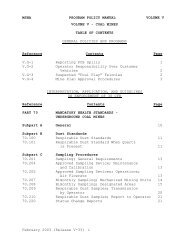MSHA HANDBOOK SERIES - PH13-V-1 - Mine Safety and Health ...
MSHA HANDBOOK SERIES - PH13-V-1 - Mine Safety and Health ...
MSHA HANDBOOK SERIES - PH13-V-1 - Mine Safety and Health ...
You also want an ePaper? Increase the reach of your titles
YUMPU automatically turns print PDFs into web optimized ePapers that Google loves.
COAL MINE SAFETY AND HEALTH<br />
GENERAL INSPECTION PROCEDURES <strong>HANDBOOK</strong> CHAPTER 3<br />
accepted by A&CC must be installed <strong>and</strong> maintained as evaluated <strong>and</strong> must<br />
have an <strong>MSHA</strong> acceptance label attached to the blue outstations, classified<br />
sensors, <strong>and</strong> classified barriers. The failure to use systems maintained in<br />
permissible condition should be cited under §§ 75.503 (Permissible electric face<br />
equipment; maintenance), 75.507 (Power connection points), or 75.1002<br />
(Installation of electric equipment <strong>and</strong> conductors; permissibility) as<br />
appropriate.<br />
The following checklist details the salient parts of an inspection of an AMS<br />
network. (Refer to Carbon Monoxide <strong>and</strong> Atmospheric Monitoring Systems<br />
Inspection Procedure H<strong>and</strong>book for further guidance.)<br />
a. Surface Inspection<br />
1. Review records of sensor calibrations <strong>and</strong> records of alert, alarm <strong>and</strong><br />
malfunction signals;<br />
2. Review records of weekly functional test; <strong>and</strong><br />
3. Verify the names of designated AMS operators <strong>and</strong> other appropriate<br />
personnel.<br />
Review the map or schematic<br />
1. Determine if the schematic <strong>and</strong> other maps are properly displayed <strong>and</strong><br />
are properly updated.<br />
Observe operation of system<br />
1. Determine the operational status of CO sensors;<br />
2. Review the AMS printout to determine any unusual history of sensors’<br />
malfunctions, alert <strong>and</strong> alarm signals, <strong>and</strong> abnormal readings; <strong>and</strong><br />
3. Determine the means of disconnecting the data line.<br />
Visual <strong>and</strong> audible alarms on the surface<br />
1. Verify that the AMS signals can be seen or heard by the AMS operator;<br />
2. Determine if the visual <strong>and</strong> audible alarm signals are distinguishable from<br />
the alert signals; <strong>and</strong><br />
3. Observe the operation of the manual reset for automatic warning devices.<br />
Communications<br />
1. Determine if the designated system operator has means of two-way<br />
communication with all working sections.<br />
b. Underground Inspection<br />
Air currents<br />
1. Check the velocity (minimum <strong>and</strong> maximum) <strong>and</strong> direction of the air.<br />
Release 1 (February 2013) 3-44
















